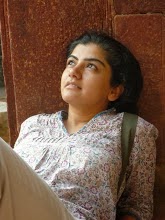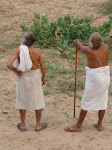We reached Chitrakoot late in the night. Our stay arrangement was at a hotel in Chitrakoot away from Akansha's family haveli in Karvi, a small town adjoining Chitrakoot. At 9.30 P.M it was pitch dark in the town. Most of the shops were shut and I had no sense of where we were. The car stopped outside an ornate haveli .... this was the first good sign.
Akansha's family is that of sarafs or jewellers and they live in a jeweller's lane. Two jewellery shops owned by the family open onto the road outside and a passage between the two leads to the first courtyard of the house. Around the courtyard are rooms and a small room dedicated to the family devta. This was presumably a mardana portion of the house in earlier days. Now the rooms on the ground floor remain locked. A second courtyard is again surrounded by rooms, one of which is home to the family cow. Both courtyards have stairs that lead to the first floor.
Akansha's grandparents occupy a large room overlooking the street outside, the first as you reach the first floor. The first floor is a replica of the ground . The four brothers have separate portions around the two courtyards on the first floor. We were served lavish south Indian dinner with a local delicacy Kheer Mohan as sweets.
Just as we were leaving for the guest house, the hostess Mrs. Agrawal concluded that ‘we’ were simple affectionate folks like ‘them’ and since we were one of them we should stay back and spend the night with the family. Soon after that mattresses were rolled out the largish kids room with a bed sofa and chaise transformed into a dormitory of sorts. I introduced my current favourite game Yahtzee to the group and as expected it did not take time for the gang to get addicted. The four nights we stayed with the Agrawals made us bored with endless entertainment and gala. There was always a pair or pairs of hands that would stretch towards us to take away our plates, glasses etc. We quickly learnt that if you wanted to eat three pooris, say no more after your first. The food was rich- actually rich is an understatement. This was hospitality par excellence. I had an eerie feeling some people could even read my mind in terms of demands. Tusha, Akansha’s younger sister who looked after their two kid sisters would ask me, “Do you need a towel... a nightie?”
The next day morning turned into afternoon quicker than before and at dusk we ventured out to explore Chitrakoot. As soon as you move out of Akansha’s house –just past the sabzi mandi you see an imposing building with a battlemented wall. It appears late 18th century and I was not surprised to see the Police Station sign board outside. It is appalling how the historic and heritage buildings in India have been damaged after Indian government turned them into public offices or institutions. These buildings have been used and abused with paan stains, thoughtless alterations, and their thick lime walls now serve as formidable piss stations. The story is the same everywhere; there is no reason to believe Chitrakoot, one of India’s 150 poorest districts to be an exception.
Despite a prominent reference in the sacred geography mentioned in the Ramayana, the most widely read literature by the Hindus today; Chitrakoot is not big on the pilgrimage map. I often wonder why some centres of pilgrimage become more popular than the others. Living in Banaras, I find that the religiosity of the city increased to popularity only after the 17th century. Though Banaras finds ancient references and archaeological data, to support claim to antiquity, it was recognized as a pilgrimage by the masses much later. Most of early Banaras was a jungle where holy men, the sadhus wandered and meditated. Dedicated pilgrims would visit Banaras but the land of Shiva was not on every pilgrims list till the British-built support system made it easier for them to. It was a heady marriage of commerce and religion that accounts for Banaras’ richer legacy in the 19th century. Most Hindu kings worth anything built imposing palaces and other buildings on the river side, aristocrats built beautiful havelis inside the city, the richer aristocrats made grander mansions outside of the city in today’s Mehmoorganj. Arts and culture patronized by these people flourished. It would not be preposterous to say that though with a varying degree of expenditure every Banarasi enjoyed countless local festivals and festive occasions.
Chitrakoot is a tirtha---- despite blaring loud-speakers and modern construction around moss-covered Mandakani, unlike other centres of pilgrimage, Chitrakoot preserves a feel of sacred geography.
It is hard to imagine thick jungles where Ram and Lakshman went in search of the golden deer in the present-day ochre-coloured land but the modern Arogaya Dham built in the Madhya Pradesh part of Chitrakoot. Arogya Dham is a resort like sanatorium in a beautiful campus. Surprising was to see a small shrine dedicated to JRD Tata. Now what is Mr. Tata’s image doing in a small Hindu pilgrimage centre. It was more surprising to discover that JRD Tata Foundation for Research in Yoga, Naturopathy and Ayurvedic Sciences has funded the entire programme.
We returned to the main dham area where the river divides the two states U.P and Madhya Pradesh. A boat ride at Chitrakoot can in no way compare the grand panoramic view that a boat ride in Banaras provides but the brightly-dressed cushion-covered boats with side pillows gave them a distinct character. What added to the royal touch were small little white rabbits that one could pet while riding.
The setting was perfect and reminded me of a short story I read some time ago about an old Banarasi festival, Burhva Mangal (lit. the old Tuesday) celebrated on a Tuesday right after Holi. Boats (locally called Bajras) of big nobles and aristocrats were dressed and decorated and they would sail on the Ganges till wee hours in the morning. Accompanying the princes and nobles would be their friends enjoying live music on board.
Just as we were sailing on the muck covered Mandakini power went out in the Uttar Pradesh side of Chitrakoot and the Madhya Pradesh side remained lit. For the few minutes that we were in this light dark zone- I had an answer to a question that has long troubled me- How and why is India still a single unit despite massive diversities?


No comments:
Post a Comment